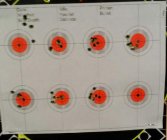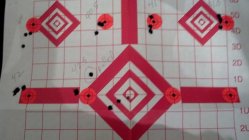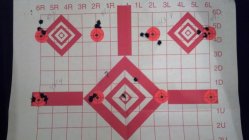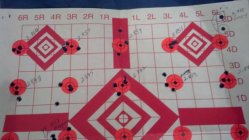Bellaire;
I would concur that there may be better loads up around 55gr (or maybe even as high as 57gr).
It depends on how your particular rifle handles the bullet, propellant, and pressure.
I would do some pressure testing in .3gr increments up to at least 55gr, paying close attention to pressure signs on fired cases before venturing to the next increment. If firing pin hole cratering, sharp primer edges, and/or significant bolt drag on opening appear, I would recommend you immediately cease shooting any higher increments, and consider the next lower, or even the one lower than that as your specific max load for that bullet and powder in that rifle.
From that point do group testing in .3gr increments downward from that chosen max. If your load testing indicates two accuracy nodes, choose the lower one for both safety and bore life considerations.
Now, here's another consideration.
For long range shooting, my experience is that as distances increase, equipment plays a smaller and smaller role, and wind skills play a greater and greater role. The issue here is that when wind skills become the predominant factor, matters like handloading complexities become less dominant.
Yes, it is true that things like load consistency contribute more greatly to vertical at the extreme distances, but the bigger question is whether this consideration outweighs things like what the environment can wreak on one's POI. Honestly, I have found that refining my loads to finer and finer pinnacles of consistency tend to get lost in the background noise of conflicting crosswinds, up- and downdrafts, and head- and tailwinds.
In essence, the most likely cause for a 9 or 8 on my 1000yd target is going to be a misread of conditions. There are wind skills masters out there, but I am not among them, and maybe some of you reading this may fall into my category.
Or not...
My most important issue is load development. A node gets chosen mainly because regardless of groups size, a good one has the preceding and successive increments centered to the same place on the target as the bracketed one. Group performance is really too few shots to establish a bulletproof statistical lock on dispersion, but group center is a far better indicator of a highly tolerant node, one that will still deliver the 10 despite the smaller inconsistencies in loads and conditions. It's a trade-off.
Velocity is not a guarantee of success or a hedge against conditions. Regardless of whether the bullet is working at a higher or a lower node, both nodes require the same application of wind skills.
Sometimes you're going to lose a point anyway, but odds are that Ma Nature is doing the chuckling and not the Load Gremlins. Do not take your rifle to the firewall to ensure this will not happen, because it still can and it still will, and all you'll achieve is an earlier failure of your barrel. Be kind to your barrel.
BTW, a longer barrel can usually attain the same desired velocity without as much mayhem going on in the throat region.
When I curtailed the extreme extra steps in handloading for 1000yd, i found almost no difference in my performance. The key attribute to my handloading is to perform what steps I do with high attention to consistency. It's not perfect, but it's not under-performing, either.
YMMV
Greg Langelius
I would concur that there may be better loads up around 55gr (or maybe even as high as 57gr).
It depends on how your particular rifle handles the bullet, propellant, and pressure.
I would do some pressure testing in .3gr increments up to at least 55gr, paying close attention to pressure signs on fired cases before venturing to the next increment. If firing pin hole cratering, sharp primer edges, and/or significant bolt drag on opening appear, I would recommend you immediately cease shooting any higher increments, and consider the next lower, or even the one lower than that as your specific max load for that bullet and powder in that rifle.
From that point do group testing in .3gr increments downward from that chosen max. If your load testing indicates two accuracy nodes, choose the lower one for both safety and bore life considerations.
Now, here's another consideration.
For long range shooting, my experience is that as distances increase, equipment plays a smaller and smaller role, and wind skills play a greater and greater role. The issue here is that when wind skills become the predominant factor, matters like handloading complexities become less dominant.
Yes, it is true that things like load consistency contribute more greatly to vertical at the extreme distances, but the bigger question is whether this consideration outweighs things like what the environment can wreak on one's POI. Honestly, I have found that refining my loads to finer and finer pinnacles of consistency tend to get lost in the background noise of conflicting crosswinds, up- and downdrafts, and head- and tailwinds.
In essence, the most likely cause for a 9 or 8 on my 1000yd target is going to be a misread of conditions. There are wind skills masters out there, but I am not among them, and maybe some of you reading this may fall into my category.
Or not...
My most important issue is load development. A node gets chosen mainly because regardless of groups size, a good one has the preceding and successive increments centered to the same place on the target as the bracketed one. Group performance is really too few shots to establish a bulletproof statistical lock on dispersion, but group center is a far better indicator of a highly tolerant node, one that will still deliver the 10 despite the smaller inconsistencies in loads and conditions. It's a trade-off.
Velocity is not a guarantee of success or a hedge against conditions. Regardless of whether the bullet is working at a higher or a lower node, both nodes require the same application of wind skills.
Sometimes you're going to lose a point anyway, but odds are that Ma Nature is doing the chuckling and not the Load Gremlins. Do not take your rifle to the firewall to ensure this will not happen, because it still can and it still will, and all you'll achieve is an earlier failure of your barrel. Be kind to your barrel.
BTW, a longer barrel can usually attain the same desired velocity without as much mayhem going on in the throat region.
When I curtailed the extreme extra steps in handloading for 1000yd, i found almost no difference in my performance. The key attribute to my handloading is to perform what steps I do with high attention to consistency. It's not perfect, but it's not under-performing, either.
YMMV
Greg Langelius

























